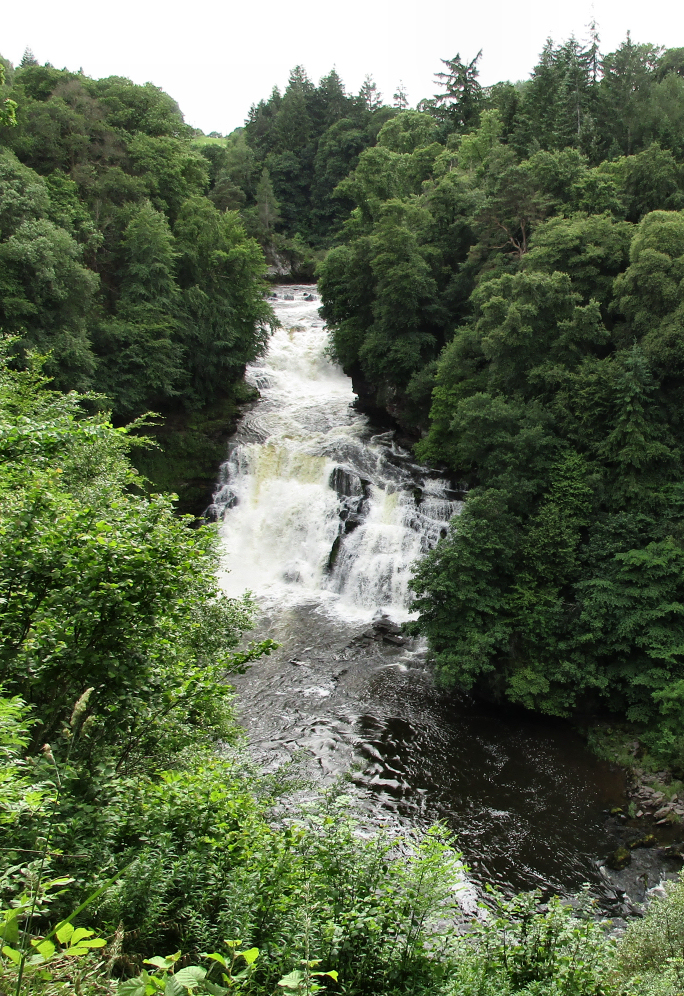Quest for Fiber:
The New Lanark Cotton Mill
I am backing up a bit to write about some of the spectacular places I have visited up until now.
In late June, I was in Glasgow and the first “go-to” place in my plans was the World Heritage Site of New Lanark. From Glasgow, it was only about a 45 minute train ride to the village of Lanark and then a mile walk down to New Lanark on the Clyde River.
I had read about this mill town before I arrived, but I was not prepared to come around a corner and see how big it was.

Established in the late 18th Century, it was taken over by a partnership that included Robert Owen in 1800. Owen was a social reformer who lived at the convergence of the Enlightenment of the 17th and 18thCenturies, the Industrial Revolution, and the time of the Highland Clearances when crofters (tenant farmers) were being forced from their farms in Scotland and moving to cities seeking work.
The education and welfare of the mill workers and their families was a high priority to Owen. He established New Lanark as a “model community” which included free medical care, enforced community sanitation to ensure good health conditions, the first “Infant School” so that mothers could return to work, school for all children, adult classes, lectures, concerts and dancing in the evenings, and garden landscapes in the town. No child under the age of 10 was allowed to work in the mill and they were encouraged to remain in school longer.

At a time when factory workers could work up to 19 hours a day, six days a week; Owen reduced this schedule to 10½ hours in his mill and withstood quite a bit of criticism from other factory owners for the decision. Indeed, he coined the expression, “Eight hours labour, Eight hours recreation, Eight hours rest.”
Owen’s work helped inspire the beginnings of the Cooperative Movement and trade unionism. Even in its time, New Lanark was recognized in Europe as a model working community and Owen was able to show that it was not necessary to treat workers poorly in order to conduct a profitable business.
This is the same Robert Owen who established the New Harmony experimental community in 1825 in Indiana in the US.
I spent the entire day walking through the exhibits showing the living quarters, spinning machinery, children’s living conditions, the non-profit company store, and today’s working spinning mill making the New Lanark Wool Yarn. The relatively modest (for a factory owner) Owen home is located within the company town, which was another thing that was unusual at the time. Inside, a fascinating documentary, Quest for Universal Harmony, about Owen’s work and philosophy was being shown. I had come to New Lanark expecting to learn about a 19th Century cotton mill, and I was pleasantly surprised to learn so much about this reformer and the movement he was a part of.
Today, the New Lanark Trust takes care of the town and it is not only a restored historical museum and education center, but it includes a hotel, a hostel, a café, and a nice restaurant, as well as low-income housing, a woolen mill, and much more.

The exhibits closed at 5:00 pm. But because the sun sets late in Scotland at this time of year, I had time to spend a couple hours walking up the nearby Clyde Valley Woodlands trail to the Falls of Clyde. There are many falls all the way up the trail and I thought I had seen them all.


As I approached the top of the trail, I had intended to turn around before the bridge at the top. Fortunately, a couple were coming down and they told me that I must cross the bridge and hike just a bit down on the other side—that the sight was amazing. So I did and was very glad I had encountered them.
Inspired?
Want to learn more about how I travel?
Click Here

scotland!!!